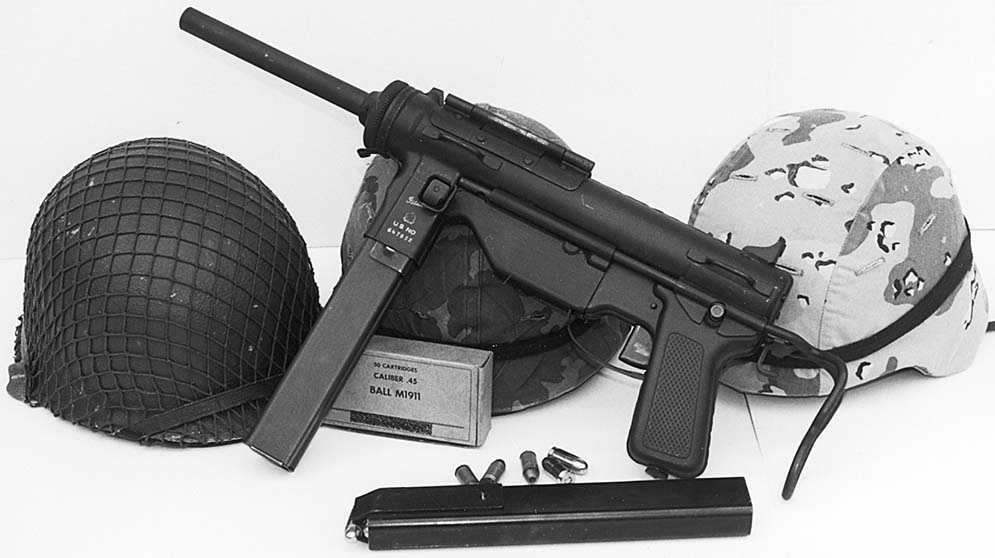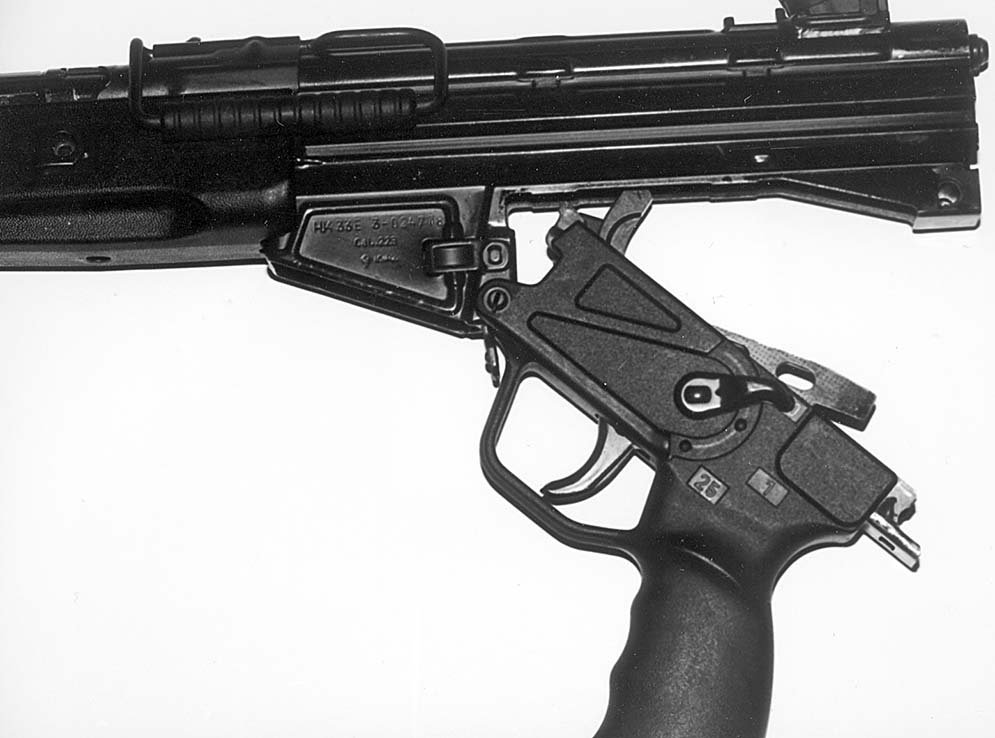By Frank Iannamico
When WWII began there was only one weapon in the submachine gun class that was readily available to the Allied forces, the Model 1928 Thompson. Because of the excellent design of the Thompson it performed well and was very highly regarded by those it served. The Thompson was so well admired that when other more cost-effective weapons were issued to replace it, many soldiers were reluctant to give turn their Tommy guns in. The biggest problem with the Thompson was it could not be manufactured fast enough, because of the large number of machining operations required to produce them. They were also very expensive. The Allied powers began looking for an alternative weapon to replace the Thompson as the war-time demand for small arms rapidly grew.
The United States Ordnance Department had set a number of requirements for the new weapon that was to replace the Thompson. One of the requirements was that the weapon could readily and easily be converted to fire the 9mm Parabellum cartridge. The 9mm was the standard issue pistol and submachine gun round for the United State’s chief ally Great Britain. It was also the round of choice for the German forces for pistol and submachine gun use.
There were extensive trials held at Aberdeen Proving Ground in Maryland to test and evaluate foreign and domestic submachine guns designs, which could meet or exceed the Ordnance Department’s requirements. One of the Hyde – Inland designs was considered for adoption early in 1942 as a substitute standard to begin replacement of the Thompson Submachine Gun. The weapon was selected as a direct result of testing at Aberdeen Proving Ground. It was one of several designs by George Hyde. During initial testing the weapon proved to be more accurate than the 1928 Model Thompson SMG using automatic fire. Several prototypes were tested before a final model successfully passed the service test. The adopted version used the standard Thompson magazine. The gun was select fire, the full automatic cyclic rate was 527 rounds per minute. In April of 1942 the United States adopted the Hyde-Inland weapon as the: U.S. Submachine Gun, Caliber 45, M2.
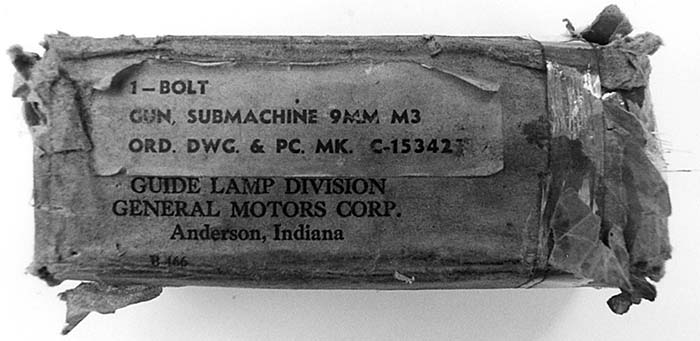
A contract for manufacturing the M2 submachine gun was bid on by the Marlin Firearms Corporation in Connecticut. Marlin was also manufacturing the United Defense UD42 Submachine Gun for the Netherlands. The M2 however, had no provision for the desired 9mm conversion. In June 1942 a contract for 164,500 M2 Submachine Guns at a tentative price of $38.58 per piece was formalized. The M2 was much simpler than the Thompson, but manufacture still required machine tools, and skilled operators. There were many other problems encountered with the production of the M2, and there were still some problems with the basic design. Several of the M2’s internal parts were designed to be manufactured by powder metallurgy to speed up production and cut costs. A difficult time with the manufacturing process was encountered partially because of the aforementioned parts. The technology was not advanced enough at the time to successfully utilize the process. The parts then had to be redesigned for machining from steel bar stock this added substantial man-hours to the M2 production time. The Marlin contract was canceled when the M3 submachine gun, commonly known as the “grease gun”, was fully developed ready to start into production. The M3, like the M2 submachine gun had some initial production problems. One was that the M3’s receiver halves were warping when they were being welded together. This and several other problems caused the Thompson production to be extended a few more months.
In item 19007 of the Ordnance Committee meeting minutes, was recorded the initiation of “a project to seek or develop a weapon to replace the Thompson”. When the prototype T-20 (M3) submachine gun was evaluated it had all of the characteristics that the Ordnance Department was looking for. In another Committee meeting held in November 1942 it was reported that: “The development of a caliber .45 submachine gun and a 9mm submachine gun: The requirements for these two weapons have been met by the development of a caliber .45 machine pistol which can be converted to 9mm operation by changing the barrel and bolt”.
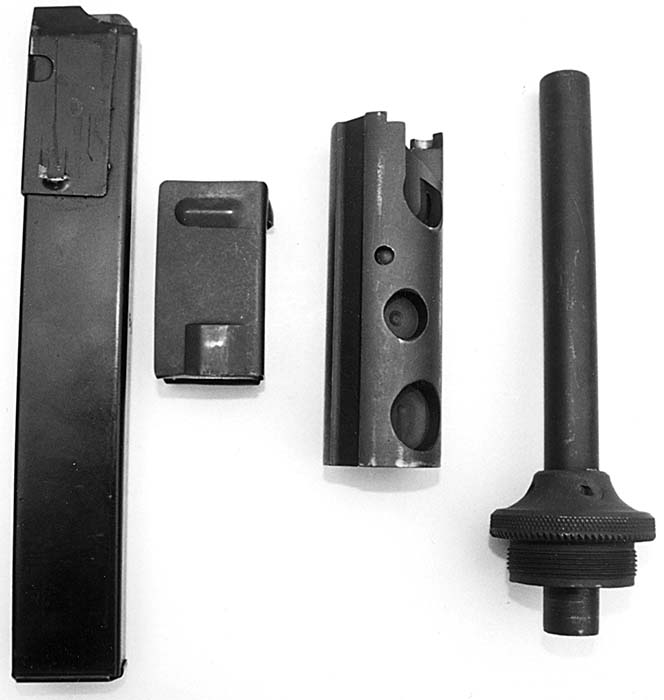
The following is from Ordnance Committee Record 19247 of November 25, 1942:
Required Characteristics and Actual Characteristics of machine pistol T-20 (M3)
1. All metal construction
1. Majority of components fabricated by stamping; remaining components require only simple machining operations.
2. Easily broken down into a small package.
2. Gun when field stripped can be packed in a box 12 3/4” x 7 1/2” x 3 3/8”
3. Cost approximately equal to that of a British Sten
3. Estimates indicate that production cost will be approximately 2/3 that of the Sten in this country.
4. Performance equal to that of the Sten
4. Tests of endurance, accuracy and functioning under adverse conditions at Aberdeen Proving Ground indicate that this weapon, in both 9mm and caliber .45 sizes is superior in all respects to any United States or standard foreign weapon.
Signed: Rene R. Studler
Colonel, Ordnance Department
Chief, Small Arms Development Branch – Technical Division
The weapon being referred to in the above memo was the U.S. M3 submachine gun, which was commonly referred to as the “grease gun”. The M3 was primarily a .45 caliber weapon, but was able to be quickly converted to fire the 9mm Parabellum cartridge by changing a few parts provided in the conversion kit.
The 9mm Conversion Kit Components: Bolt assembly C153425, Barrel Assembly C153435, Adapter C153430. Today the 9mm conversion kit is one of the rarest accessory items available for the M3 grease gun. They were manufactured for issue by the Office of Strategic Services (OSS). The conversion kits were originally planned for use in the European and Pacific Theaters, though none were ever issued to U.S. troops. The 9mm cartridge was very common in Europe during World War II making it much easier to obtain by resistance groups that the OSS was planning to supply with the M3. The conversion kits could also make the M3 readily adaptable for use by the British especially when using the Sten SMG magazine. The British however preferred their own 9mm MK II Sten submachine to the U.S. M3.
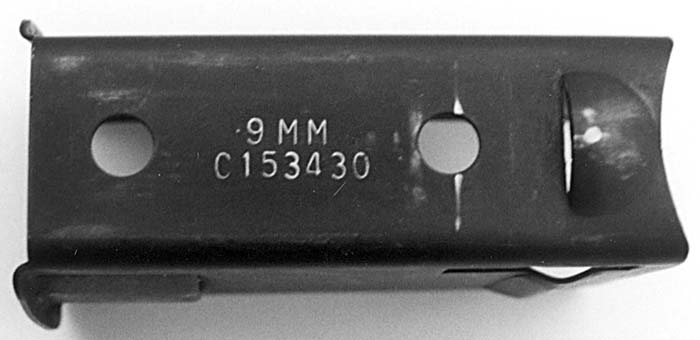
The 9mm kits were made for the M3 and later for the M3A1, the only difference being the configuration of the bolt. The kit consists of a magazine adapter, 9mm barrel assembly, a special 9mm bolt and a standard 9mm British Sten magazine. It had originally been requested that 25,000 kits be manufactured. It is believed that a much lesser amount was actually produced. The rarity of the kits today suggests that few were actually made. In December 1943, the Ordnance Committee recommended that 500 of the 9mm conversion kits for the M3 be obtained as a limited procurement item. In February of 1944, procurement was authorized. The parts were manufactured by the Rock Island Arsenal and by Buffalo Arms (bolts). The 32 round Sten magazines would be obtained from the British government. The few M3 kits examined were all marked RIA for Rock Island Arsenal.
Only one M3A1 kit has been observed to date. The only difference between the M3 and the M3A1 kit is the bolt. The M3A1 bolt was designed to eliminate the cocking handle of the M3, and to allow easier disassembly of the weapon. The M3A1 has a longitudinal slot that runs the entire length of the bolt, and a different stop plate that allows the bolt and guide rod assembly to be removed without removing the trigger guard and ejector housing. The M3A1 is cocked by the operator placing his finger inside a machined area in the bolt, and pulling the bolt rearward. The M3 has a cocking handle that mechanically retracts the bolt.
The three-sided magazine adapter is manufactured from one piece of .030 inch thick spring steel and easily snaps into place in the magazine well. It is held in place by two metal tangs on each side. The standard M3 magazine release is used. Removal of the adapter is more difficult and sometimes the magazine release button must be removed to facilitate removal of the adapter. While the 9mm bolts and barrels are sometimes found as separate pieces, the adapters are seldom encountered. The adapter is certainly the rarest part of the kit.
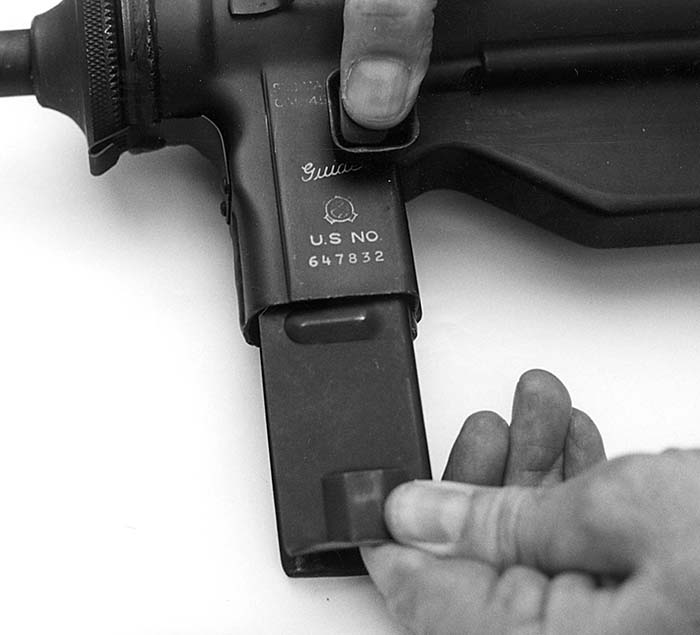
The installation of the bolt and barrel assembly is the same as for the standard .45 caliber parts. The 9mm barrel is the same length and outside diameter as the standard .45 caliber unit. The barrel nut is the same as for a standard M3, but the originals are stamped “9mm” on the inside surface of the nut. The 9mm barrel extends 5/16s of an inch further out of the rear of the barrel nut than a standard .45 calber barrel. This is necessary to reliably feed the shorter 9mm round into the barrel’s chamber. The bolt is similar, but the bolt face is set back considerably further than on a standard bolt to compensate for the extended barrel. The as mentioned earlier, the magazine is a standard 32 round Sten magazine. The 50 round magazine made for the British Lanchester submachine gun will also fit and function with the conversion kit. The cyclic rate of the M3 with the 9mm kit installed is very similar to the slow 400 rounds per minute as in the .45 caliber configuration. Full power 9mm rounds are required to operate the weapon. Although the 9mm bolt is lighter in weight than its .45 counterpart the same recoil springs are used. There are often feeding problems with the conversion, because of the shorter overall length of the 9mm round, and the distance from the chamber of the barrel. The M3 doesn’t have a conventional feed ramp, the cartridges are pushed from the magazine directly into the chamber of the barrel.
This article was excerpted from the new book “ The U.S. M3 and M3A1 Submachine Gun”. The book is available from Moose Lake Publishing 207-683-2959.
| This article first appeared in Small Arms Review V3N9 (June 2000) |



